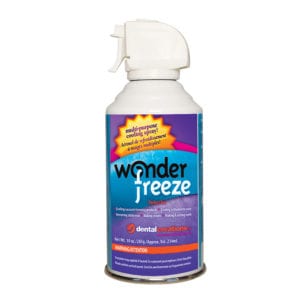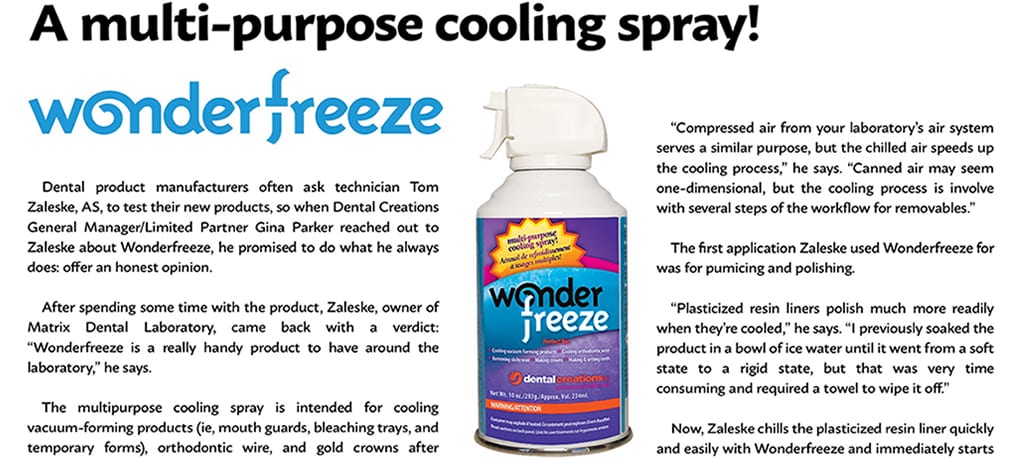
Dental product manufacturers often ask technician Tom Zaleske, AS, to test their new products, so when Dental Creations General Manager/Limited Partner Gina Parker reached out to Zaleske about Wonderfreeze, he promised to do what he always does: offer an honest opinion.
After spending some time with the product, Zaleske, owner of Matrix Dental Laboratory, came back with a verdict: “Wonderfreeze is a really handy product to have around the laboratory,” he says.
The multipurpose cooling spray is intended for cooling vacuum-forming products (ie, mouth guards, bleaching trays, and temporary forms), orthodontic wire, and gold crowns after soldering. It can also be used to cool wax in the crown-and-bridge department, among many potential applications.
Zaleske, a removables specialist who lectures around the country, found several usages within his laboratory.
“Compressed air from your laboratory’s air system serves a similar purpose, but the chilled air speeds up the cooling process,” he says. “Canned air may seem one-dimensional, but the cooling process is involved with several different steps of the workflow for removables.”
The first application Zaleske used Wonderfreeze for was for pumicing and polishing.
“Plasticized resin liners polish much more readily when they’re cooled,” he says. “I previously soaked the product in a bowl of ice water until it went from a soft state to a rigid state, but that was very time consuming and required a towel to wipe it off.”
Now Zaleske chills the plasticized resin liner quickly and easily with Wonderfreeze and immediately starts the finishing process.
“It saved me time, and it made the liner cooler and more rigid than ice water did,” he says. “I can pumice it and get a nice, high shine finish.”
Please with that application, Zaleske began thinking of more. One obvious use for Wonderfreeze, he realized, was for setting teeth in wax. On a hot day in a large production laboratory, especially one in which flames are used instead of electric waxing instruments, the room can get warm, causing teeth to migrate during the setting of the denture.
“I know it is aggravating when you are setting up a denture case and, when you go to close it, the tooth has moved because the wax is soft from the warm environment,” Zaleske says. “If you have a can of Wonderfreeze next to you, just a little spritz cools the wax sufficiently to prevent the teeth from migrating.
Another use, Zaleske says, is for finishing PFM copings with diamonds – cooling them with Wonderfreeze can help technicians avoid burning their fingertips during this process.

Finally, Wonderfreeze has proven specially useful for vacuum forming.
“When vacuum forming, you always get a little rebound,” Zaleske says. “If the vacuum is on, you pull the sheet down over the top of it and then you turn it off to avoid burning out your motor because it’s dragging against something that is blocking the vacuum. When you take off the vacuum, you get a bit of rebound. The material is not ion the same position as it is when the vacuum is on because it is still hot. It gets heat soaked.
“I found that spraying air while the product is under vacuum cools it off extremely quickly so when I turnoff the vacuum it does not rebound because it freezes the product in its vacuuming position. It provides modicum of better accuracy because it is still adapted to the vacuum when you freeze it.”
With all of those uses, Zaleske says, Wonderfreeze is worth having around. “It is just another thing to improve my workflow,” he says.
Article by: Tom Zaleske
About the Author: Tom Zaleske is the owner of Matrix Dental Laboratory in Crown Point, Ind., and has more than 25 years of experience in removable prosth-odontics. He regularly lectures on providing high quality service to dentists and, most importantly, to their patients. He can be reached at matrixdental@comcast.net.


